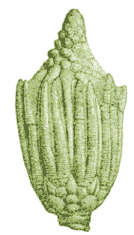Geology / Gallery

Eucalyptocrinites decorus (3)
Crinoids are animals that have been around since Cambrian times.
In the Silurian they contributed substantially to the widespread deposits of fossiliferous Silurian limestones.
The animals had stems with which many forms were anchored to the sea bed, the 'cup' shown in the picture has the arms (brachia) closed up. When feeding the arms opened out to catch tiny food particles. Later forms are able to swim freely in search of food. They belong to the major Echinoderm group which includes such modern day forms as starfish and sea urchins.
Eucalyptocrinites decorus lived in the Silurian and was first identified in England.
| Division | Name |
| Phylum | Echinodermata |
| SubPhylum | Crinozoa |
| Class | Crinoidea |
| Subclass | Inadunata |
Fossil gallery
- Brittle Star : Lapworthia miltoni
- Trilobite : Dalmanites myops
- Crinoid : Eucalyptocrinites decorus
- Gastropod : Poleumita discorus
- Trilobite : Calymene blumenbachi
- Graptolite : Cyrtograptus murchisoni
- Sponge : Ischadites koenigi
- Conodont : Ozarkodina typica
- Brachiopod : Pentamerus oblongus
- Graptolite : Petalograptus minor
- Brachiopod : Chonetes striatellus
- Cystoid : Lepocrinetes quadrifasciatus
- Bivalve : Pteronitella retroflexa
- Graptolite : Monograptus lobiferus
- Gastropod : Platyceras haliotis
- Crinoid : Sagenocrinites expansus
- Brachiopod : Atrypa reticularis
